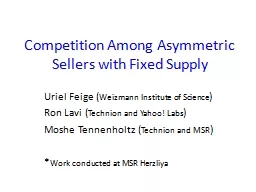PPT-Motivation: markets for ads
Author : liane-varnes | Published Date : 2017-03-20
Thousands of advertisers Handful of publishers B1 B2 B3 Bn q1 q2 A bstract view Publishers Determine allocation of slots to advertisers based on budgets given
Presentation Embed Code
Download Presentation
Download Presentation The PPT/PDF document "Motivation: markets for ads" is the property of its rightful owner. Permission is granted to download and print the materials on this website for personal, non-commercial use only, and to display it on your personal computer provided you do not modify the materials and that you retain all copyright notices contained in the materials. By downloading content from our website, you accept the terms of this agreement.
Motivation: markets for ads: Transcript
Download Rules Of Document
"Motivation: markets for ads"The content belongs to its owner. You may download and print it for personal use, without modification, and keep all copyright notices. By downloading, you agree to these terms.
Related Documents














